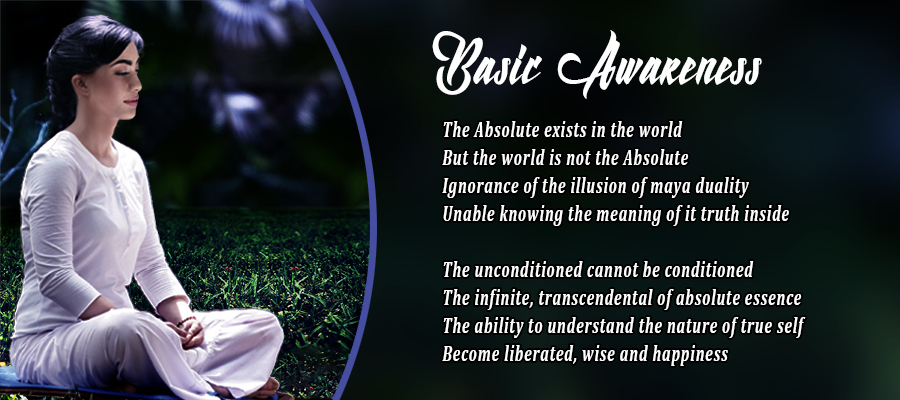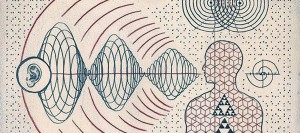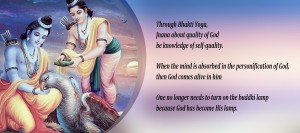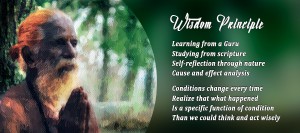As with every fresh cycle man comes to an awareness of the All-pervading, he tries to dis-cover the means for realizing It. It was Hiranya garbha, we are told, who first taught yoga or the Divine Way, but it was his successors, Gaudapada and Patanjali, who developed it into a regular system. As we have already seen in the foregoing chapter, all true yoga begins with a dualistic assumption but ends in a non-dualistic one. It is not surprising, therefore, that many students of the inner science should have been confounded by this paradox.
As time passed, confusion led to controversy, and a half-truth was often mistaken for the full truth. It was at such a time that Shankara, the prodigy from South India, arose to preach the true philosophy of Advaitism. He was gifted with amazing powers of reasoning, logic and insight and few have attained to the depth, subtlety and consistency of vision that are to be found in Shankara’s writings. Taking up all the great scriptures as they came down from the past, he unequivocally interpreted their meaning and established their identity of substance.
He showed that the Reality was One and, in its ultimate analysis, could not tolerate any pluralism or dualism. An individual jiva might begin as distinct from the Brahman, but by the time he had attained full realization, he would have realized his oneness with the Absolute, the All-pervading. Armed with clairvoyant intellectual power, he swept Indian thought clean of all the seeming contradictions that were clogging its free development.
We may now examine some of the basic concepts that he taught.
Self — the basis of conscious life
Shankara regarded the empirical life of the individual consciousness as nothing but a waking dream, and as any other dream, an unreal substance. Its unreality comes to light when one travels from limited to cosmic consciousness, or contemplates the relative nature of physical consciousness as it varies from waking (jagrat), to dream (swapan), and from dream to dreamlessness (sushupti). If empirical experience is relative in character, wherein lies its reality? The answer provided by Shankara is that it is to be sought in the Thinking Mind, which in turn only reflects the light of the Atman, the Eternal Self, the unchanging, the absolute, the real wit-ness (sakshi).
The principle of causality is just a condition of knowledge. The objects appear to be real so long as we work within the limits of cause and effect. The moment we rise above these limitations, all objects vanish into airy nothings. In the true nature of reality, there is no place for causation, because causal explanations are always incomplete and ultimately lead nowhere. The objects momentarily appear as bubbles or ripples on the surface of the water and disappear the next moment into the water and are no more. Water alone remains the real substratum of the whole phenomenon.
In just the same way, the Real contains and transcends the phenomenal, and is free from all relationships of time, space and cause. The entire world lives in the mind of man, and it is the movement of the conscious mind that produces the distinctions of perception, the perceiver and the perceived, a differentiation where in fact there is none, as everything is part of the vast ocean of unity. This state does not recognize the distinctions of knower, known and knowledge, all of which are but relative terms with no finality about them.
Similarly, the three states of the human experience (waking, dreaming and the dreamless) are unreal, for none of them lasts long enough, and each gives place to the other in turn, as the mind passes from state to state. Each of them has a beginning and an end and exists only in the absence of the others. The term “relativity” in itself implies its antithesis, the “Reality,” and beyond the three states specified above lies the atman, as the basis of them all. It alone is and constantly remains, behind the ever-changing panorama of life, the ever unborn, eternally awake, the dream-less and self-illumined, by its very nature a pure cognition distinct from the non-cognition of the sleep state.
The nature of creation
Creation as such does not exist per se. The actual and the real is ever the same and is not subject to change. The unconditioned cannot be conditioned as infinity cannot be finitized. All that is, is Brahman, and there can be nothing apart from the Absolute Unity. It projects It-self into varying forms, which are an expression of Its power, but if we perceive them in terms of plurality or duality and of limitation, it is not that such qualities in here in the Absolute, but that our own perception is limited by the narrow, everyday, human consciousness.
He who has passed from Avidya to Vidya, from ignorance to knowledge, knows the world of the relative to be only maya or illusion, and sees the Absolute in everything, just as he who knows the true nature of ice sees it only as another form of water.
The power of the Absolute, popularly known as Ishwar and called the Creator, is the root cause of all consciousness. The world of plurality or duality is mere maya, an instrument for measuring things on the level of the intellect, while the real One is non-dual and hence is at once measureless and immeasurable.
As an empirical experience is neither identical with the atman, nor exists apart from or independent of the atman, so the world is neither one with the atman nor separate from it.
Atman is one and universal, unconditioned and limitless like space, but when conditioned by mind and matter, it looks like Ghat-Akash or space enclosed in a pitcher, yet becomes one with the universal space when the pitcher breaks apart. All the differences, then, are but in name, capacity and form. The jiva and the atman are one and of the same essence. Kabir, speaking of it, says that the spirit is part and parcel of Ram, or the All-pervading Power of God. While the jiva is conditioned and limited by the limiting adjuncts, physical, mental and causal; the atman or the disembodied jiva, freed from these finitizing adjuncts, is limitless and unconditioned.
The basis of truth lies in Self-certainty
The Self precedes everything else in the world. It comes even before the stream of consciousness and all concepts of truth and untruth, reality and unreality, and before all considerations, physical, moral and metaphysical. Consciousness, knowledge, wisdom and understanding presuppose some kind of energy known as “Self” to which all these are subservient; and in fact, they flow from it.
All physical and mental faculties, even the vital airs and empirical experiences, appear in the light of the shining Self, the self illuminated Atman. They all have a purpose and an end that lie far deeper than themselves and which form the springboard for all kinds of activity, whether physical, mental or supramental.
All these, however, fail to grasp the real nature of the Self, being themselves in a state of continuous flux. Self being the basis of all proof and existing before proof, cannot be proved. How can the Knower be known, and by whom? Self is in fact, the essential nature of everyone, even that of the atheist. This Self then, is eternal, immutable and complete, and in its essence, is ever the same at all times, under all conditions and in all states.
The nature of Self
Though we know that the Self exists, yet we do not know what it is, for knowledge itself follows the Self and is due to and because of the Self. The true nature of the Self may however be comprehended by the Self, if It could be stripped of all the enshrouding sheaths of senses, mind, understanding and will, in which it is clothed and covered.
What is then left is variously described as “Undifferentiated Consciousness,” “Eternal Knowledge” or “Pure Awareness,” and is characterized by the Light of the Great Void.
It is the supreme principle whose essential nature is self-effulgence. It is infinite, transcendental and the essence of absolute knowledge. It has three attributes of Sat, Chit and Anand, i.e., pure existence, pure knowledge and pure bliss. As the Self is complete in Itself, and by Itself, It has no activity of Its own, nor has any need for it, nor requires any outside agency. All-pervading and self-existent, It knows no limits and no motives.
Individual knowledge and consciousness
Though the ultimate reality is the non-dual spirit, yet determinate knowledge and empirical experience presuppose the existence of:
- The knower, or the subject that knows apart from the internal organ behind the senses and the object known. The knowing mind is but a reflecting mirror that reflects the luminosity of the atman, in which knowledge grows.
- The process of knowledge as determined by modifi-cations in the internal organ: vritis or undula-tions creating ripples and bubbles in the stream of consciousness. These vritis are of four kinds: the Indeterminate (manas or the mindstuff), the Determinate (budhi or intelligent will), Self-sense (ahankar or the self-assertive ego), and the Subconscious (chit or the deep and hidden potencies).
- The object known through the light of the atman as reflected by the internal organ (antah-karana).
Knowledge and its sources
Knowledge is of two kinds: ultimate and final, or empirical and relative. Knowledge in its ultimate reality is a state of being and never grows. It is already there and is revealed by the light of the atman, which transcends at once both the subject apprehending and the object apprehended, beyond which there is nothing.
True knowledge is purely an action of the soul and is perfect in itself and independent of the senses and the sense organs. “An all knowing mind” says Professor J. M. Murray, “embraces the totality of being under the aspect of eternity.
As we gain our entrance into the world of being, a total vision is ours.” According to Shankara, “ highest knowledge is the immediate witness of reality itself ” for then, the knower and the known become one reality. But the real Self which is pure awareness cannot be the object of knowledge.
The empirical knowledge of the external world is just like animal knowledge. It is based on and derived from the sense organs, and as such has forms and modes all of which are conspicuous by their absence from true knowledge. But nothing becomes real till it is experienced. Even a proverb is no proverb until it is illustrated in actual life and practice.
All empirical knowledge is revealed either by perception or by scriptural testimony. The human perception has never been considered true, perfect and accurate. One may see a snake in a rope, or a ghost in the stump of a tree. Generally, things are not what they seem to be. The colors of things we see are those that are not absorbed by them, but are rejected and thrown out. The redness of the rose is not part of the rose but something alien to it. Again, inference and scriptural testimony are not altogether infallible. The source of inference is previous experience, which is itself fallible, and even if it were not, situations in the present may not wholly fit in with the knowledge gained in the past. This is the case even with intuition, which is the sum-total of all experience in the subconscious. A cloud of smoke on the top of a distant hill may be indicative of fire, or it may be a sheet of fog.
Similarly, scriptural testimony, though admitted as an infallible and certain source of knowledge, cannot always be treated as such. The Vedas, which constitute the Divine knowledge, appear and disappear with the rise and dissolution of each cycle of time. They are supposed to be an inexhaustible mine of universal and ideal knowledge.
But the term “knowledge” implies a record of spiritual experiences gained at the super-sensory planes. The moment the experiences thus gained are translated into human language and reduced to writing, they acquire form and method, and the moment they acquire form and method, they lose their freshness and life, their quality of limitless being. That which cannot be limited or defined, begins to be treated as some-thing defined and limited, and instead of the scriptures giving vital knowledge, they tend to dis-tract men from it by offering only abstractions. At best they can only point toward the Truth, but they can never give it.
The concepts of the Universal as contained therein, remain as mere concepts, for they can neither be received, inferred nor correctly communicated; they begin to have meaning only when one learns to rise above the empirical plane and experiences Truth for himself.
From the above, one comes to the irresistible conclusion that “seeing,” or direct and immediate perception, is above all proof and testimony. It is seeing in the pure light of the atman, which is free from even the least shadow of correlativity. It is nothing but a direct, integral experience of the soul. Sruti, or revealed scripture, without first-hand inner experience, is sound without sense. All flights of thought, imagination or fancy, and all empirical knowledge, are inadequate and cannot do justice to Truth or the Ultimate Reality.
Anubhava is verily the real and absolute knowledge, and is knowledge of the Absolute. It is the self-certifying experience of the soul, which bears testimony to the recorded spiritual experience of the sages as given in the srutis.
The nature of Brahman
The very idea of finitude implies the existence of the Infinite, as does the word “unreal” of something real, the basis of all intelligence and imagination. Again, we have the overwhelming testimony of scriptural texts, which speak of religious experiences of all seers at all times and in all places.
The nature of Brahman cannot be expressed in words. It is the foundation of all that exists. It spreads everywhere, and at the same time is nowhere in relation to anything particular. It is a paradox at once of being and non-being.
There are two ways of looking at the problem: the negative way and the positive way.
There is God, the Incomprehensible Absolute, and God Who actually creates, works, and is the First Cause, and is known variously as the Jiva, Soul or Spirit, the Kalma or the Bang-i-Qadim, the Naad or the Udgit, the Naam or the Shabd.
The latter terms indicate the life principle, the Word or the Power of God that is immanent and vibrates everywhere from the highest to the lowest in the Universe. It is both the material and the efficient cause of the world. It is the principle of Truth and the spirit of God (God in action — Ekankar).
This power of Brahman (Ishvara) or Godhead is the medium between Brahman and the Universe and partakes of the nature of both. But His oneness is not affected by self-expression into many Eko aham bahu-siam. The two exist as reality and appearance, and the difference arises because of the limited insight in man.
To sum up, the Supreme Reality is the basis of the world as we know it, speak of it and see it. The plurality, or diversity in unity, is the result of erroneous judgment. The world is unreal but not a subjective illusion. The Absolute is in the world but the world is not the Absolute, for a shadow cannot take the place of the substance. A thing based on the real cannot be the “real” it-self. The world is but the phenomenal truth and not the essential truth of the Reality, or the centripetal force at the core of it.
The individual self is a complexity of likes and dislikes, preferences and prejudices, purposes and projects, memories and associations.
The conditioned jiva is essentially the unconditioned atman. This empirical self or the individual understanding is, through ignorance of its own real nature, the active doer, the enjoyer and the sufferer in the pure light of the atman, of which it has no knowledge nor any experience. Enclosed in the physical body, composed of five elements (ether, air, fire, water and earth), is the subtle body consisting of seventeen elements (five organs of perception: eyes, ears, nose, tongue and skin; five of action: sight, hearing, smell, taste and touch; the five vital airs; and manas and budhi), and also the causal or seed body.
The self follows the inexorable law of karma as it migrates from one body to another on the giant Wheel of Life. These limiting adjuncts (the physical, mental and causal), reduce the atman to the level of a jiva (individual consciousness), and determine its fate, taking it into endless gyres.
In the core of the jiva is the Witnessing Self, that merely looks on and sheds luster on the entire stage and, while illumining the ego, mind, senses and the sense objects, continues to shine in Its own light, even when the stage is cleared. It is against this illumined silver screen that the whole show takes place.
The attainment of the state where the atman knows itself for what it is and realizes that it is naught but Brahman, is the goal of Advaitism. This state is one of direct experience and, as Shankara has made abundantly clear, it cannot be attained merely by ratiocination, the reading of scriptures or the performance of rituals. It can come only through the pursuit of yoga; and the essential thing to be remembered is that Advaitism by itself is not a yoga but, strictly speaking, represents the philosophy of yoga at its subtlest and profoundest.
Shankara, as he himself clarified, was not speaking of something new. He was engaged in the task of reformulating what had already been expressed in the Upanishads and the Gita. Endowed with an extraordinary intellect and an amazing flair for logic, he set about restating in a coherent and systematic form the in-sight embedded in the srutis, which in subsequent times had been confused and had led to much needless controversy.
He demonstrated once and for all that any approach to Brahman which did not preach the non-pluralistic and non-dualistic reality was in its very nature illogical, and that Advaitism was in fact the logical conclusion of yogic thought.
Implicit in this approach was the view that of all states of samadhi, the one in which the individual atman lost its identity in the Brahman (called Nirvikalp Samadhi), was the highest. This state was to be attained here and now, and one could be free in this life (jivan mukta). He who had plumbed beneath the phenomenal to the Absolute, would never again be taken in by appearances. He was a liberated spirit, living in the light of True Knowledge. Past actions might carry him onward through physical existence, but once these were exhausted, he was absorbed wholly into the Brahman, the pure cognition.
Shankara was indeed a remarkable man of learning and insight, and his contribution to Indian thought is permanent. In carrying it to its logical conclusion, he gave it the brilliance of consistent clarity. But just as ritual and scripture cannot be a substitute for direct inner experience, likewise merely knowing that the Self and the Brahman are One cannot take the place of an actual experience of this union. The philosophy of yoga is not the same thing as yoga. At best, it can only clear our thinking of its present confusion and point out the final goal to be attained, but the rest must remain a matter of practical and personal realization through yoga.
Advantages of Yoga
The advantages of the yoga of contemplation or dhyana are innumerable. One engaged in this form of yoga can by mere contemplation have all his desires fulfilled. “As you think, so you become,” is a well-known aphorism. By contemplation on the attributes of God one can develop these attributes within one’s own self and be a witness and a testifier to Heaven’s Light, while his senses acquire transcendental powers. The mind also tastes of the bliss of vigyan, when the chit vritis, or the mental modulations, are stilled.
This yoga rids one of all sins, and one feels an inner bliss and halcyon calm. All kinds of mental maladies like fear, shame, vacillation and self-assertiveness, disappear gradually and give place to fearlessness, confidence, firmness and happiness, and one acquires an evenness of temper in all the varying conditions of life. He is not obsessed either by attachment or detachment, and like a lotus flower, floats above and over the slime of common existence. With the knowledge of the true values of life, he grows firm in his convictions and is no longer a prey to the ground-less fears and chance winds that blow over him. He has no cause for praise or blame and as such, talks little and does much; all of his acts are motivated by kindliness and good will toward all. His words are honey-sweet and authoritative. He is not tormented by pride and prejudice, but leads a life of perfect moderation and justice. He conquers indolence and idleness; eats little and sleeps little and there is hardly any difference in his state of wakefulness and slumber.
He is ever the same throughout, with a radi-ant and a beaming face that bespeaks his inner glory.
Shamadi
The term samadhi is derived from two Sanskrit roots: sam with its English equivalent “syn” means “together with,” and adhi (the Primal Being) with its Hebrew equivalent of Adon or Adonai which denotes “Lord;” the two together, sam plus adhi, denoting a state in which the mind is completely absorbed in the Lord or God. It is a state in which all limiting forms drop away and the individual, with his individuality all dissolved, experiences the great truth — Ayam Athma Brahma — ”I am Thou.”
It is the last and culminating stage in the long- drawn-out process of experimental yoga, and may therefore be said to be the efflorescence of the yogic system. The dhyan itself gradually develops into samadhi when the contemplator or the meditator loses all thought of him-self, and the mind becomes dhyarupa, the very form of his thought. In this state the aspirant is not conscious of any external object save of Consciousness itself, a state of all Bliss or perfect happiness.
There are two means through which the state of samadhi may be attained. The Vedehas (or those who rise above body-consciousness), achieve it by destroying the very nature of the mind-stuff which runs after material objects all the time, by channelizing it to a one-pointed attention inward. The others develop this state by practicing in the first instance discernment and discrimination through faith, energy and memory. There are other variations of samadhi as well.
In dhyan or meditation (one-pointed attention), one retains the distinction between the contemplator and the contemplated, but in samadhi, or identification with the totality, even these disappear, for one’s own individuality is, so to say, annihilated. It is this absorption into the Infinite that gives liberation from all finitizing adjuncts, for then one gets an insight into the very heart of things and has an experience of the subtle (adhi-devaka) and the abstract (adhi-atmic) aspects of all that exists.
Samadhi, or identification with the Absolute, may be accompanied with consciousness of one’s individuality, in which case it is known as savi-kalpa, or it may not be accompanied with any such consciousness and is then known as nirvikalpa. The former was compared by Sri Ramakrishna to a cotton doll which when put in water gets saturated with it, and the latter to a doll of salt which when immersed in water dissolves and loses itself in it. Of these, nirvikalpa is clearly the higher, for savikalpa, though it greatly widens one’s vision, is yet only a preliminary step toward the unconditioned state. Not all yogins can achieve nirvikalpa, and those that do attain it generally do so only once in their life. They thereby finally escape the realm of name and form and become liberated souls. Their unfructified karmas, both past and present (sanchit and kriyaman) can no longer bind them, but the momentum of their present lives (prarabdha) must be completed and must be lived to the very end. On returning from nirvikalpa, or the unconditioned state, to everyday human consciousness, they live and move as other human beings. But while engaged in worldly duties, they are forever centered in the Divine and are never separate from It.
We may also mention yet another form of samadhi, called Bhava Samadhi, in which the devotee, lost in devotional music and singing, loses all thought of himself and the world around. This form of samadhi is easy to attain for those of an emotional temperament and affords momentary ecstasy and inner mental relief, but it does not give atonement with the Divine or expand one’s consciousness. As such, the term samadhi is only loosely applied to it, for it displays none of the central attributes of the super-conscious state, nor is it therefore of much help on the inner spiritual journey.
Each one of us is endowed with a rich inner life, full of untold spiritual gems of which ordinarily we are not conscious in the work-a-day present life of the senses that we usually lead. We can turn inward and expand our vision so as to embrace within its fold not only a cosmic life but even a super-cosmic life as well, extending into vistas beyond the human ken. It is a state of being, a direct perception, an integral experience of the soul, an immediate and direct knowledge of spiritual anubhava (inner realization), as it is generally called.
Professor Bergson, a great philosopher, believed and felt that there was a higher source of knowledge than intellect, which is confined to ratiocination or the reasoning process. He called it intuition, but this state of being goes even beyond intuition to direct and to immediate knowledge, for intuition is only another name for the sum total of one’s past experiences. An ordinary man does not have to reason or intuit about the sun in order to believe in its existence. It is there before him, it is prataksha and that renders all proof unnecessary. “All true knowledge exists by itself and is quite independent of the senses. It is the action of the soul and is perfect without the senses …” says Ben Jonson. “The surest way into Truth,” says Henri Bergson, “is by perception, by intuition, by reasoning to a certain point, then by taking a mortal leap.” It is divya drishti or jnana chakshu (i.e., direct experience of the soul, of the Reality Itself). It is through spiritual flashes and glimpses from beyond that one gets some view of Truth in the form of spiritual in-sight, inspiration and revelation. The spiritual experience, though it stands by itself and is beyond the furthest limits of reason, does not however contradict reason, but makes reason perfect.
Again, samadhi is chaitanya or all consciousness, as distinguished from jar samadhi. A Hatha yogin, by the practice of Khechari Mudra, with-draws his pranas into the Sahasrar Chakra, the seat of the jiva-atma or soul, and can sit in a mountain cave or underground cavity in this state of inanity for months and years. This is a kind of yoga nidra or yogic sleep, and does not give any super-sensory knowledge or spiritual experience. As opposed to this, one who is in chaitanya samadhi is in a state of perfect aware-ness and can come out of it at will with a new supra-mental experience and spiritual wisdom. In jar samadhi, one cannot break the samadhi by oneself and others have to do it by a complicated procedure of massages, etc. A Raja yogin, a Bhakta or a Jnana yogin, can be awakened easily by someone merely shaking his body, or by blowing a conch or striking a gong. This chaitanya samadhi is achieved when the gunas, devoid of motion, become dormant and the power of consciousness gets established in its own nature; hence it is often termed as kaivalya sama-dhi or a samadhi of perfect ease and independence.





